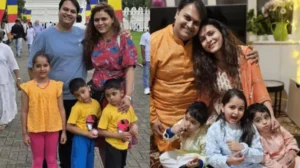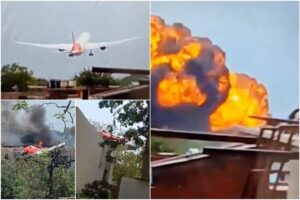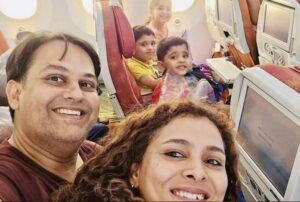On June 12, 2025, a radiant selfie captured a moment of pure joy aboard Air India Flight AI171, a Boeing 787-8 Dreamliner bound for London’s Gatwick Airport. Pratik Joshi, a 37-year-old software professional who had built a life in London over six years, beamed alongside his wife, Dr. Komi Vyas, and their three children—eight-year-old Miraya and five-year-old twins Nakul and Pradyut. The photo, sent to relatives in Rajasthan, marked the culmination of a long struggle to secure visas for his family to join him in the UK. But just 32 seconds after takeoff from Ahmedabad’s Sardar Vallabhbhai Patel International Airport, their dream turned to ashes. The plane crashed into a medical hostel in Meghaninagar, killing 241 of the 242 aboard and at least 24 on the ground. The sole survivor, a British national seated far from the Joshi family, emerged from the wreckage, leaving their story as a haunting symbol of hope extinguished.
A Six-Year Odyssey
Pratik Joshi’s journey began in 2016 when he left his hometown of Banswara, Rajasthan, for London, driven by ambition to build a better future. A skilled software engineer, he secured a job in the UK’s tech sector, renting a modest flat in South London and meticulously planning for his family’s arrival. His wife, Dr. Komi Vyas, a respected pathologist at Pacific Hospital in Udaipur, remained in India, raising their three children while teaching at a medical college. The couple, married for a decade, endured years of separation, their nightly video calls filled with dreams of reuniting.

The UK’s stringent visa process posed relentless challenges. Pratik navigated bureaucratic hurdles, securing sponsorships and financial proofs to bring Komi and the children to London. Komi, determined to join him, resigned her hospital post days before the flight, packing their lives into suitcases filled with school uniforms, children’s books, and Rajasthani sweets for their new home. The children, excited for their first international journey, wore matching sweatshirts, their eyes bright with anticipation. On June 11, the family traveled from Banswara to Ahmedabad, accompanied by relatives who waved them off at the airport, unaware it would be their final goodbye.
The Ill-Fated Flight
Flight AI171 carried 242 passengers and crew, including 169 Indian nationals, 53 British citizens, seven Portuguese, and one Canadian. Among them were former Gujarat Chief Minister Vijay Rupani, a spiritual British couple running a wellness center, and young cabin crew members from Manipur. The aircraft, piloted by Captain Sumeet Sabharwal (8,200 flight hours) and First Officer Clive Kundar (1,100 hours), took off at 1:38 p.m. local time under clear skies, expected to land in London by evening.

But the flight lasted mere seconds. At 625 feet, the plane issued a “Mayday” call, signaling a critical failure. Videos showed it struggling, nose pitched upward, landing gear down, and flaps possibly unextended, unable to climb. It veered sharply and crashed into the BJ Medical College hostel, a residence for doctors and students, igniting a fireball that consumed the building. The explosion sent black smoke billowing, visible across Ahmedabad, as debris littered the streets. The plane’s tail, lodged in the hostel’s ruins, stood as a grim testament to the disaster’s scale.
A Shattered Community
The crash’s toll was staggering. Of the 242 aboard, 241 perished, including the entire Joshi family. On the ground, at least 24 residents, including five medical students and a doctor’s spouse, died as the hostel’s canteen, bustling with lunchtime activity, was obliterated. Over 260 bodies, many charred beyond recognition, were recovered, with DNA testing underway at Ahmedabad Civil Hospital. Survivors from the hostel, some who leaped from upper floors, sustained fractures and burns, their futures as healers now uncertain.
The sole survivor, Vishwash Kumar Ramesh, a 40-year-old British national of Indian origin seated in 11A near an emergency exit, escaped through a door as flames erupted. Ramesh, unrelated to the Joshi family, suffered bruises and impact injuries but was stable. His survival, while miraculous, deepened the tragedy for families like the Joshis, who sat far from the wing’s fortified area. Ramesh’s anguished search for his brother, seated elsewhere, echoed the despair of countless relatives gathered at hospitals, clutching photos and fading hope.
A Family’s Final Moment
The Joshi family’s selfie, shared on X and seen by millions, has become a heart-wrenching symbol of loss. Pratik and Komi, seated on one side of the aisle, smiled warmly, while Miraya, Nakul, and Pradyut grinned across from them, their excitement palpable. The photo, captioned “Our new beginning,” was sent to Pratik’s cousin Nayan, who later described the family’s joy: “They were finally together, ready for London.” The image, now called “the saddest selfie ever” online, captures a fleeting moment of promise, frozen before the sky gave way.

In Banswara, the Joshi family’s home is shrouded in silence. Neighbors, unable to speak, gather outside, while Komi’s colleagues at Udaipur Medical College check her empty desk, as if expecting her return. Pratik’s father, a renowned radiologist, and Komi’s brother Prabuddha, a businessman, face the grim task of identifying remains. The children’s schoolbags, packed with notebooks for their London school, remain untouched, a painful reminder of dreams unfulfilled.
A Nation in Mourning
India reeled from the tragedy, its worst aviation disaster in decades. Prime Minister Narendra Modi, a Gujarat native, visited the crash site, consoling families and overseeing relief efforts. Home Minister Amit Shah and Civil Aviation Minister Ram Mohan Naidu coordinated rescues, with the Indian Army and National Disaster Response Force recovering bodies amid smoldering debris. Air India, owned by the Tata Group, offered ₹1 crore (about $116,000) per victim’s family and established support centers in Ahmedabad, Mumbai, Delhi, and Gatwick. The airline’s social media went black, and flights were diverted as Ahmedabad airport suspended operations.
Globally, leaders expressed solidarity. U.S. President Donald Trump pledged investigative aid, with the National Transportation Safety Board joining India’s Aircraft Accident Investigation Bureau (AAIB). British Prime Minister Keir Starmer and King Charles III mourned the 53 British victims, including a wellness couple whose final social media post celebrated India’s “mind-blowing” experiences. The AAIB, alongside Boeing and GE Aerospace experts, is analyzing the recovered Flight Data Recorder, with theories pointing to engine failure, bird strikes, or pilot error. The Cockpit Voice Recorder, still missing, may hold clues to the pilots’ final actions.
Questions of Safety and Fate
The crash, the first fatal incident for the Boeing 787 Dreamliner, has shaken confidence in a model prized for efficiency. Preliminary findings suggest the plane’s engines failed to generate thrust, with videos showing anomalies like unextended flaps. Pratik, a meticulous planner, had chosen Air India for its reliability, unaware of the mechanical or human factors that would betray his trust. The hostel’s proximity to the airport, just 600 meters from the runway, has sparked calls for stricter zoning laws, as urban sprawl encroaches on safety buffers.
Online, the Joshi family’s story has ignited grief and reflection. Posts on X describe Pratik’s six-year struggle as a testament to love and perseverance, only to end in tragedy. Users call the selfie a reminder of life’s fragility, with one writing, “Their smiles are etched across the sky.” The contrast between the family’s loss and Ramesh’s survival fuels discussions of fate, with some questioning why one seat—11A—meant life, while others, like the Joshis’, meant death.
A Legacy of Love
In Banswara, the Joshi family’s legacy endures through memories of their warmth and ambition. Pratik, soft-spoken but determined, built a life in London with his children’s future in mind. Komi, a dedicated doctor, inspired her students and cherished her twins’ laughter. Miraya, described as bright and curious, dreamed of seeing London’s museums, while Nakul and Pradyut planned to ride double-decker buses. Their story, though ended abruptly, resonates as a universal tale of hope and sacrifice.
As investigators probe the black box, Ahmedabad mourns, and the world reflects, the Joshi family’s selfie remains a poignant artifact of a dream cut short. The sole survivor, Vishwash Kumar Ramesh, carries the weight of his escape, unaware of the family whose smiles lit up the cabin moments before disaster. For Pratik, Komi, and their children, the journey to London was more than a flight—it was a promise kept after years of waiting, now forever lost to the skies.


